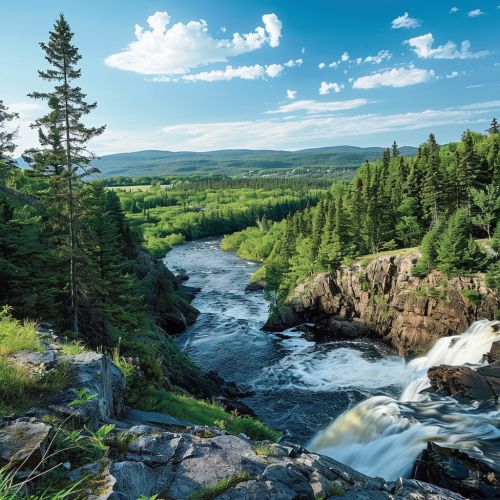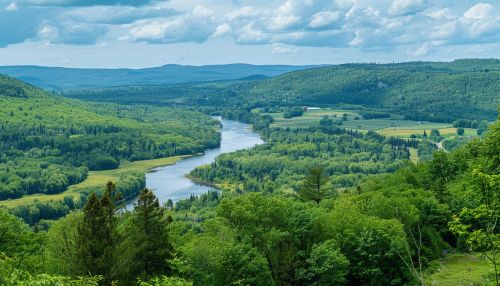Quebec
Geography
Quebec, the largest province in Canada, is located in the eastern part of the country. It is bounded to the north by Hudson Strait and Ungava Bay, to the east by the province of Newfoundland and Labrador, to the southeast by the Gulf of Saint Lawrence, the provinces of New Brunswick and Maine, and to the south by the states of New Hampshire, Vermont, and New York. It is bordered to the west by the province of Ontario, with the boundary largely following the Ottawa River, and by James Bay and Hudson Bay.


The province's landscape varies from the fertile Saint Lawrence Lowlands in the south to the rugged Appalachians in the south-east, the Laurentian Mountains in the central region, and the flat and barren terrain of the Canadian Shield in the north. The northern region of Quebec is part of the Arctic Cordillera, with its tundra and ice fields.
History
Quebec's history begins with the arrival of the Algonquin and Iroquoian peoples thousands of years ago. The first Europeans to arrive were the Vikings around AD 1000, followed by the French explorer Jacques Cartier in 1534. The French established the first permanent European settlement in Quebec, Quebec City, in 1608. The colony of New France was established, with Quebec City as its capital.
In 1763, following the Seven Years' War, New France was ceded to Britain and renamed the Province of Quebec. The Constitution Act of 1791 divided the province into Upper and Lower Canada. The Act of Union 1840 reunited them as the Province of Canada. In 1867, the Province of Canada was divided again into the provinces of Quebec and Ontario, and they became part of the newly formed Dominion of Canada.
Quebec has a distinct culture and language due to its French heritage. The Quiet Revolution in the 1960s modernized Quebec and led to a rise in Quebec nationalism and the sovereignty movement. The issue of Quebec sovereignty was put to a vote in two referendums, in 1980 and 1995, both of which failed.
Politics
Quebec's political system is a type of parliamentary democracy known as a constitutional monarchy, where the Monarch of Canada is the head of state and the Premier of Quebec is the head of government. The National Assembly of Quebec is the legislative body, composed of 125 members elected from single-member districts.
Quebec has a unique political culture in Canada, with a strong nationalist movement and distinct political parties, such as the Parti Québécois and Quebec Solidaire, advocating for Quebec sovereignty or increased autonomy.
Economy
Quebec's economy is diverse and post-industrial, with a large emphasis on the knowledge economy. It is the second-largest economy in Canada, with a GDP of C$380.972 billion in 2017. The province has abundant natural resources, including forests, mines, and hydroelectric power. Major industries include aerospace, technology, pharmaceuticals, and film and television production.
Culture
Quebec is known for its unique culture, which is heavily influenced by its French heritage. The province is predominantly French-speaking, with French being the official language. Quebec's culture is also characterized by its music, literature, cinema, and popular festivals, such as the Quebec Winter Carnival and the Montreal International Jazz Festival.
